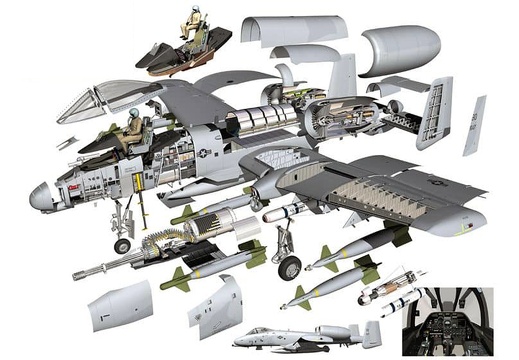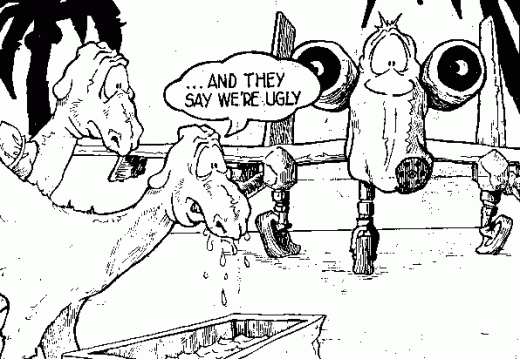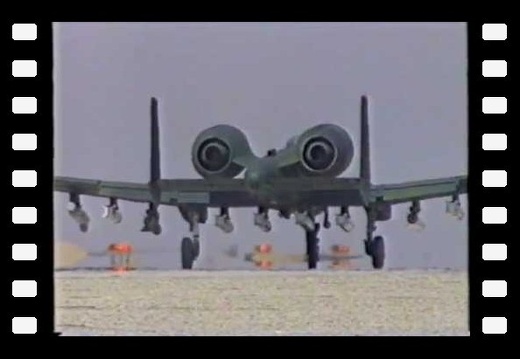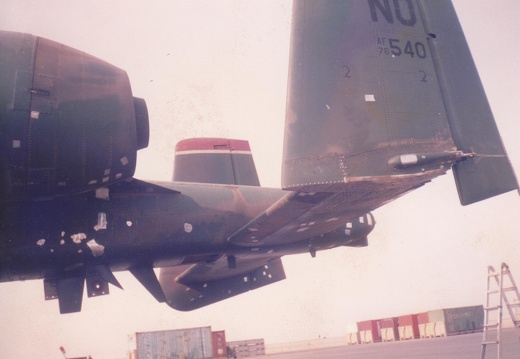
A-10 760540
Gulf War Battle Damage A-10 76-0540 (Repaired)
A-10 76-0540 from the New Orleans Air Force Reserve. Became the first heavily damaged aircraft on January 31, 1991 suffering major damage when struck by a surface-to-air missile. All hydraulic controls were lost. The pilot, Major Jim Rose, managed to bring it home to us first landing at KKMC and then limped back to KFIA using backup systems.
76-0540 sat out the rest of the war due to lack of parts. TSgt Runge and TSgt Patrick McGee (me) removed and replaced the entire empennage on this thing.
It did finally fly home, well to McClellen AFB anyway, where it supplied parts for other A-10's for awhile until August 22, 1991 when we ended up putting her on static display at the McClellan AFB Aviation Museum (now Aerospace Museum of California), Sacramento (North Highlands) CA.
It did finally fly home, well to McClellen AFB anyway, where it supplied parts for other A-10's for awhile until August 22, 1991 when we ended up putting her on static display at the McClellan AFB Aviation Museum (now Aerospace Museum of California), Sacramento (North Highlands) CA.
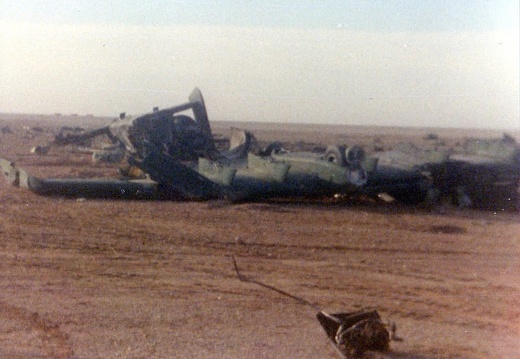
A-10 770197
Gulf War Battle Damage A-10 77-0197 (Destroyed)
OA-10A 77-0197, 23rd TASS/602nd TACW crashed killing pilot Lt Patrick Olson (posthumously promoted to Captain) after a reconnaissance mission over Kuwait on 27 Feb 1991, call sign NAIL 51. Aircraft had been hit by a surface-to-air missile (SAM) in the aft end. Lt Olsen attempted to land it at KKMC FOL in Manual Reversion after loosing all its hydraulics and brakes, in extreme weather conditions and with only one engine. On landing aircraft hit a little short, bounced twice on the soft overrun where on the second bounce the gear sunk into the ground and sheared off. The aircraft started sliding and turned a little sideways when the left wing started gaining lift and the aircraft became airborne again, almost 50 feet airborne. The left wing kept getting lift and the plane rolled inverted until it cart wheeled wingtip over wingtip flipped over on to its back killing the pilot Lt Olson. With the aircraft inverted there was no chance of ejection. On scene reports say the reason Lt Olson didn't eject earlier was because his neck was broken on the first landing bounce. A sad day indeed. There was nothing left of the aircraft. The remains of the aircraft were buried in a desert pit at the FOL (along side 79-0181).
77-0197 wreckage is in the pit before being buried in the Saudi desert. The aircraft on the sling being added into the pit is A-10 79-0181.
WARTHOG NEWS August 12, 2010 Lt Olson had been victim of another battle damage in an A-10 on 14 Feb just days before this fatal day. On a low-level mission on Feb. 14, 1991, Olson’s OA-10 was hit by a bullet that struck the lower left-hand part of his canopy and and bounced off. Uncertain if his plane had suffered serious damage he headed for home and landed safely. My ABDR team and I scratched our heads trying how the bullet had gouged out a messy dent in the fuselage only 2 feet from Olson’s head and didn't hurt him. Luck was on his side that day.
77-0197 wreckage is in the pit before being buried in the Saudi desert. The aircraft on the sling being added into the pit is A-10 79-0181.
WARTHOG NEWS August 12, 2010 Lt Olson had been victim of another battle damage in an A-10 on 14 Feb just days before this fatal day. On a low-level mission on Feb. 14, 1991, Olson’s OA-10 was hit by a bullet that struck the lower left-hand part of his canopy and and bounced off. Uncertain if his plane had suffered serious damage he headed for home and landed safely. My ABDR team and I scratched our heads trying how the bullet had gouged out a messy dent in the fuselage only 2 feet from Olson’s head and didn't hurt him. Luck was on his side that day.
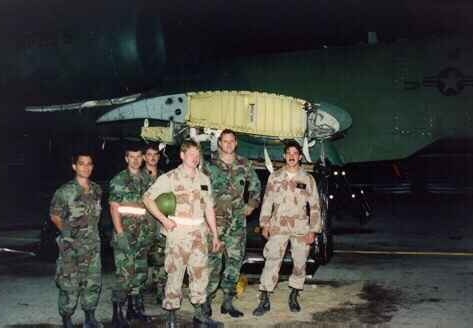
A-10 770255
Gulf War Battle Damage A-10 777-0255 (Repaired)
Another 354 TFW New Orleans AFRES jet hit on 5 Feb 91. Damage included large holes in left wing, left engine, right tail. Took us only 4.5 days to replace the entire right wing. Nose Art "Camel Jockey".
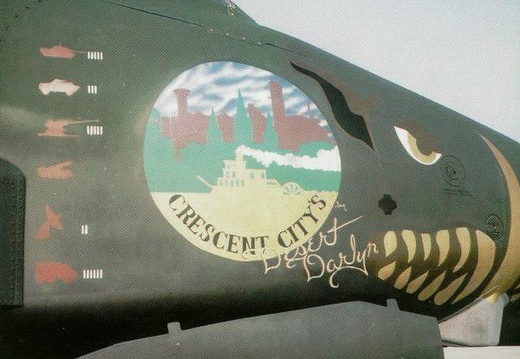
A-10 770268
Gulf War Battle Damage A-10 77-0268 (Repaired)
31 Jan 91, 926th TFG/706th TFS (NO), Shrapnel damage in left cockpit area and RT engine by 37MM AAA. Col Bob Efferson, Commander, 926th TFG brought this battle damaged A-10 "Crescent Citys Desert Darlyn" riddled with 378 holes back to KFIA on 31 Jan 1991. Damage to Vert tail, horz tail, aft fuselage, both wings, left engine cowling. Blew left main tire after landing, skidded off the runway. 2 weeks to recover to MOB and then cannibalized. Sent to AMARC as AC0148 26 Oct 1992; still at AMARC as of 15 Jan 2008. No Battle Damage photos A-10 77-0268, but here's some nose art.
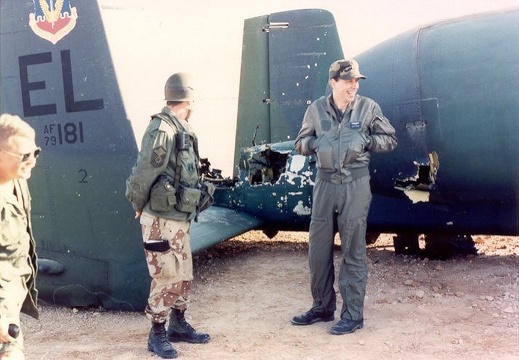
A-10 790181
Gulf War Battle Damage A-10 79-0181 (Destroyed)
Wheels up, hard stick landing after being hit by a SAM. Everyone said it couldn't be done, including the Flight Manual's and Tech Orders... pilot Capt Rich Biley proved'm wrong on 22 Feb 1991! He brought 79-0181 in at King Khalid Military City (KKMC), Forward Operating Location (FOL) 1 where the CLSS team stripped it of parts, some send to King Fahd International Airport (KFIA), Main Operating Base (MOB) for use on other birds, and then buried it in the desert. Capt Biley was unhurt during the crash.
We later worked together in 1995 at Osan AB, Korea where he was assigned to the 25th FS and I was the Superintendent of the 51st FW Maintenance Operations Center.
We later worked together in 1995 at Osan AB, Korea where he was assigned to the 25th FS and I was the Superintendent of the 51st FW Maintenance Operations Center.
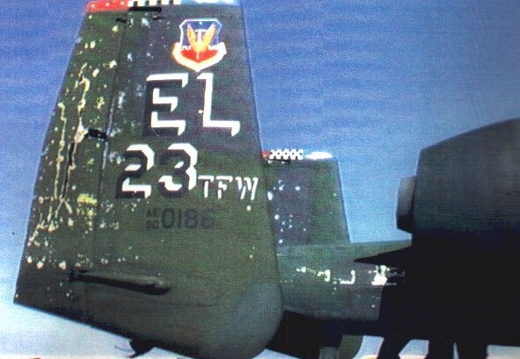
A-10 800186
Gulf War Battle Damage A-10 80-0186 (Repaired)
ACFT Tail # Incident Date Unit Severity Description of Damage Repair Time Event # 18. A‑10 80‑0186 1-Feb-91 23TFW Damaged Front windscreen below HUD. R&R front windscreen, 24‑hour cure E‑20 19. A‑10 80‑0186 15-Feb-91 23TFW Damaged Hits both rudders, right elevator gone. 11 days‑2 weeks, 139 m/h F‑23 Col David Sawyer's, commander 23 TFW, aircraft was battle damaged on three different occasions, one being the "Golden BB" hitting the front windscreen, and the last being the infamous "300 holes" time as a result of an SA-16 exploding near it on 15 Feb 1991 that hit both rudders and took the right elevator off. The photo's that show "NO" on the tail were taken after we installed verticals from 76-0540. We had it back in the air flying in 7 days.
ACFT Tail # Incident Date Unit Severity Description of Damage Repair Time Event # 18. A‑10 80‑0186 1-Feb-91 23TFW Damaged Front windscreen below HUD. R&R front windscreen, 24‑hour cure E‑20 19. A‑10 80‑0186 15-Feb-91 23TFW Damaged Hits both rudders, right elevator gone. 11 days‑2 weeks, 139 m/h F‑23 Col David Sawyer's, commander 23 TFW, aircraft was battle damaged on three different occasions, one being the "Golden BB" hitting the front windscreen, and the last being the infamous "300 holes" time as a result of an SA-16 exploding near it on 15 Feb 1991 that hit both rudders and took the right elevator off. The photo's that show "NO" on the tail were taken after we installed verticals from 76-0540. We had it back in the air flying in 7 days.
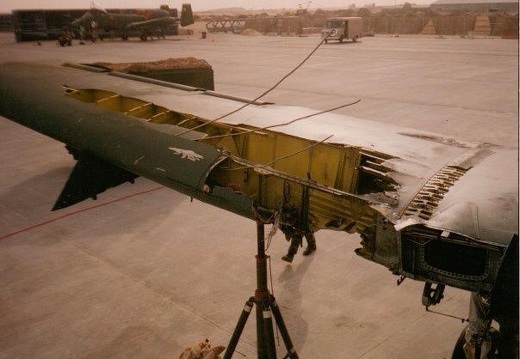
A-10 820664
Gulf War Battle Damage A-10 82-0664 (Repaired)
Flew 22 missions total. Sustained major wing damage Feb 6, 1991, but was brought back by pilot Capt Paul "PJ" Johnson. Major depot level repairs in the field including center wing replacement!
SMSgt Keith, one of our 2951 CLSS members, was reinlisted in front of this aircraft during its repair.
To AMARC 14 Mar 2001, Return to Service 9 May 2001 (23rd FG, Pope AFB), Arrived AMARG 19 Apr 2007, Return to Service date unknown.
SMSgt Keith, one of our 2951 CLSS members, was reinlisted in front of this aircraft during its repair.
To AMARC 14 Mar 2001, Return to Service 9 May 2001 (23rd FG, Pope AFB), Arrived AMARG 19 Apr 2007, Return to Service date unknown.
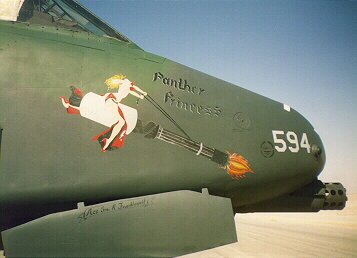
A-10 Nose Art
One of the artists of the New Orleans' 926th Fighter Group, 706th FS, was Kevin Smith, the Avionics Shop Chief at KFIA.
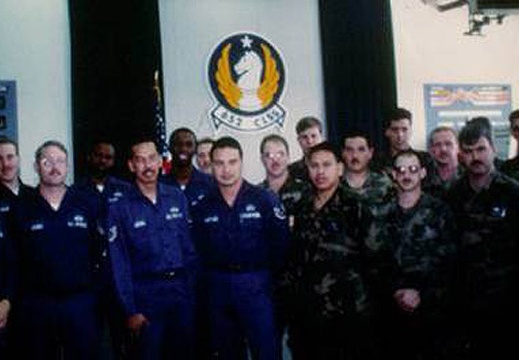
CLSS Through The Years
Photos from the 1960s - 1990s
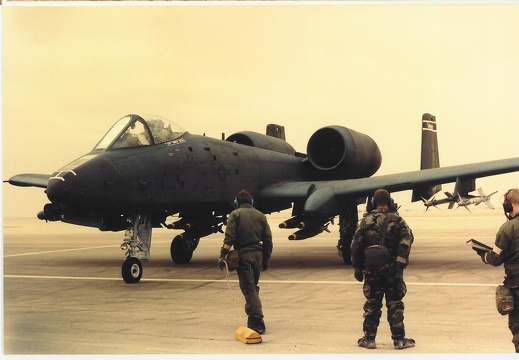
EOR and the RAMP
Tertiary Battle Damage inspections were accomplished during EOR (End of Runway) checks. Many times an aircraft sustained battle damage without the pilot ever knowing it. The Tertiary ABDR inspections found many such instances of minor damages.
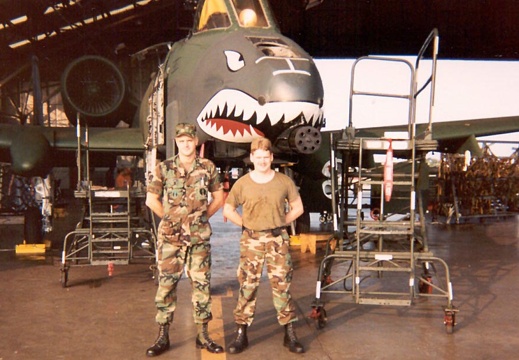
England AFB Predeployment 1990
England AFB APOE (Aerial Port of Embarkation) August 1990 2951st CLSS APOE was England AFB, LA, departing with the 23rd Tactical Fighter Wing, Sept 1990. We spent 3 weeks beginning in Aug 1990 living in downtown Alexandria LA, working at England on the 23 TFW aircraft. We performed major maintenance on 79-084, got re-certified on the M-16, and helped the 23rd TFW launch jets during the deployment. Some of my team members I can remember are: SSgt Allen Van Cleef, TSgt Sherman London, TSgt Mike Brannon, Sgt Mike Reiter, Sgt Tim Porter, SSgt Dave Seimer, TSgt James Clagett, Sgt Jeff Barnes, SSgt Jeff Langford, MSgt Rick McClure, MSgt Nick Martinez, Chief James Jefferson, Sgt Kendall Sierakowski, Capt Poe (engineer), SSgt Robson, Sgt King, Sgt Paul "The Dice Man" Labra", SSgt Scott Ridgeway, SSgt Jeff Rasmussen, TSgt Gene Harrel, TSgt Robert Runge, Sgt Willy ??, Sgt Brian Bowers, SSgt Greg Young, SSgt Dave Pentecost. There are others, I just can't remember names... sorry guys. How did we end up at England AFB? We departed McClellan AFB on military aircraft and flew down to Davis Monthan, where we thought we would wait for airlift to Saudi, but in reality we didn't even stay at DM one full day. In the middle of the first night we were instructed to get to England AFB any way we could, and mil air was not available. So, we broke down all our war gear, pallets, and weapons, and flew commercial to New Orleans airport. Since the weapons were all palletized, we had no cases for them. We borrowed cases for each M-16 from the folks at DM. When we arrived at the airport in New Orleans, where we expected transportation waiting from England... there was none. It took 6+ hours of communication and transportation time to get a flatbed and trucks to us. While we were all there, the rock band Ted Nugentcame thru. This was a big deal to many of our team members. The band talked with some of us, asking if we were a band and if the cases were out instruments haha. We finally got our transportation and headed for England AFB, where we stayed several weeks. M-16 Training and RefresherMany deployed from McClellan AFB without current M-16 certification. Actually it wasn't a CLSS requirement to stay current, but that proved to be a bad thing when we actually had to go to war. So, while at England, we all went thru re-cert. Dover AFB We stayed a couple days at Dover AFB after leaving England and awaited transportation to Saudi.
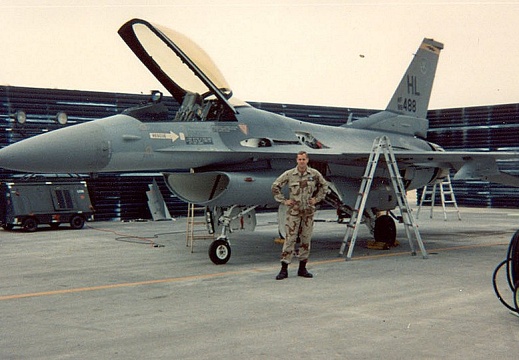
F-16 880488
Gulf War Battle Damage F-16C, 88-0488 (Repaired)4th TFS Hill AFB Utah was hit by a SA3 on 21 Jan 1991, which exploded behind his tailpipe peppering the aircraft. It could not make it back to its home base in Qatar so it stopped with us. Several of us had F-16 experience, which made things easier.
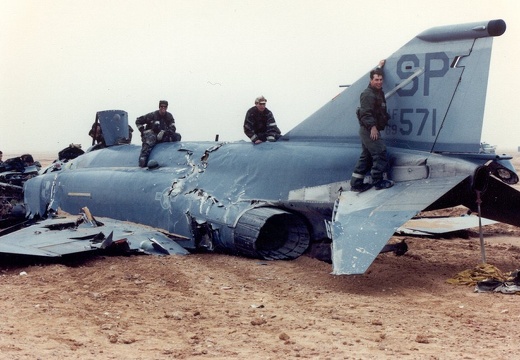
F-4 697571
Gulf War Battle Damage F-4G "Wild Weasel" Phantom 69-7571 (Crashed/Destroyed)
This F-4G Advanced Wild Weasel was from the 81st TFS, 52 TFW, Spangdahlem AB Germany (Tail Code 'SP') deployed to Sheikh Isa AB, Bahrain and was one of the last F-4 units in operation. This was the only F-4G lost during Desert Storm. It crash landed at KKMC (FOL 1) due to fuel starvation after small arms hits punctured fuel tanks on January 18, 1991 [Gulf War 1991 Chronology By Easy Tartar]. Original reports stated it was a mechanical failure. It became the 7th US Combat Loss. Both crew members Capt Tim Burke (pilot) and Capt Jaun Galindez (EWO) ejected safely.
Coming back from a target it missed the orbit of the tanker it was to refuel from. There was not enough fuel to fly past the tanker and then circle back to line up for refueling so the pilot decided to land at Al Kharj Airbase, Saudi Arabia. As luck [bad luck] would have it, heavy earth moving equipment had accidentally cut the runway landing lights and the base was covered in fog. The F-4G was right over the runway, but just couldn't see it. The crew made several landing attempts at KKMC, which was basically zero-zero at the time. On the 5th pass Capt Burke ran out of gas so the crew members [successfully] ejected and 69-7571 bellied in. After the crash SMSgt Beebe and the 2951 CLSS ABDR team assigned at KKMC stripped it and buried it in the desert.
To this day a lot of speculation exists about the actual cause of the crash. But according to the Air Force Historical Research Agency report titled "USAF MANNED AIRCRAFT COMBAT LOSSES 1990-2002" the F-4G Wild Weasel aircraft was hit while flying against air defense sites in Iraq and as a result lost fuel. The two crew members were rescued because they ejected after returning over friendly territory. On Dec 3, 2009 Mike Gardner a pilot in the squadron during the war left a message on the Guestbook stating 69-7571 diverted out of the tanker tracks to the designated alternate airfield. The alternate was WXSOF. The aircrew made three attempts to find the runway but had to eject on short final when the jet ran out of gas.
McDonnell F-4G Phantom II / F-4 Phantom II on Global Security / F-4 Phantoms Phabulous 40th: Wild Weasel (Boeing)
Dean Vinson writes on 7 Dec 2016: At about 0530 on 19 January 1991, in darkness and impenetrable fog and all but out of fuel, the crew of that F-4 requested a barrier landing at the airfield just south of King Khalid Military City, Saudi Arabia. I was the base civil engineer and at the airfield, and set out in a truck for the southeast end of the runway to watch the engagement--but had to stop for fear of running into something or someone in the fog. I sat where I was and wondered how in the hell to react when I couldn't see ten feet in front of me, and listened to the clipped communications from the supervisor of flying and the airfield director and the tower on the crash net, and to the sounds of the F-4 overhead on two missed approaches, then a third, then the firing of the ejection seats--and then, in what in my memory wasn't much time at all, the fire department saying they had the pilot and backseater and both were okay. When it got light we found the jet, relatively intact and having incredibly fortunately not hit any of the numerous things it could have hit. -- Dean Vinson
Coming back from a target it missed the orbit of the tanker it was to refuel from. There was not enough fuel to fly past the tanker and then circle back to line up for refueling so the pilot decided to land at Al Kharj Airbase, Saudi Arabia. As luck [bad luck] would have it, heavy earth moving equipment had accidentally cut the runway landing lights and the base was covered in fog. The F-4G was right over the runway, but just couldn't see it. The crew made several landing attempts at KKMC, which was basically zero-zero at the time. On the 5th pass Capt Burke ran out of gas so the crew members [successfully] ejected and 69-7571 bellied in. After the crash SMSgt Beebe and the 2951 CLSS ABDR team assigned at KKMC stripped it and buried it in the desert.
To this day a lot of speculation exists about the actual cause of the crash. But according to the Air Force Historical Research Agency report titled "USAF MANNED AIRCRAFT COMBAT LOSSES 1990-2002" the F-4G Wild Weasel aircraft was hit while flying against air defense sites in Iraq and as a result lost fuel. The two crew members were rescued because they ejected after returning over friendly territory. On Dec 3, 2009 Mike Gardner a pilot in the squadron during the war left a message on the Guestbook stating 69-7571 diverted out of the tanker tracks to the designated alternate airfield. The alternate was WXSOF. The aircrew made three attempts to find the runway but had to eject on short final when the jet ran out of gas.
McDonnell F-4G Phantom II / F-4 Phantom II on Global Security / F-4 Phantoms Phabulous 40th: Wild Weasel (Boeing)
Dean Vinson writes on 7 Dec 2016: At about 0530 on 19 January 1991, in darkness and impenetrable fog and all but out of fuel, the crew of that F-4 requested a barrier landing at the airfield just south of King Khalid Military City, Saudi Arabia. I was the base civil engineer and at the airfield, and set out in a truck for the southeast end of the runway to watch the engagement--but had to stop for fear of running into something or someone in the fog. I sat where I was and wondered how in the hell to react when I couldn't see ten feet in front of me, and listened to the clipped communications from the supervisor of flying and the airfield director and the tower on the crash net, and to the sounds of the F-4 overhead on two missed approaches, then a third, then the firing of the ejection seats--and then, in what in my memory wasn't much time at all, the fire department saying they had the pilot and backseater and both were okay. When it got light we found the jet, relatively intact and having incredibly fortunately not hit any of the numerous things it could have hit. -- Dean Vinson
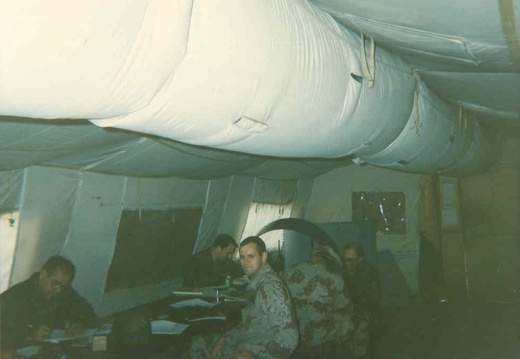
Maintenance Areas
Some of the maintenance shops and areas our CLSS teams worked from at KFIA and KKMC. At KFIA we were split into 2 separate teams, one for each end of the flight line, the England AFB at one end and Myrtle Beach at the other.
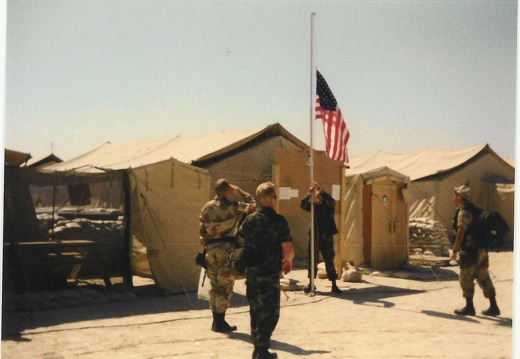
Tent City KFIA
Main Operating Base (MOB), King Fahd International Airport (KFIA), Saudi Arabia
Our home away from home during our deployment. All I can say is it could have been worse.
Our home away from home during our deployment. All I can say is it could have been worse.
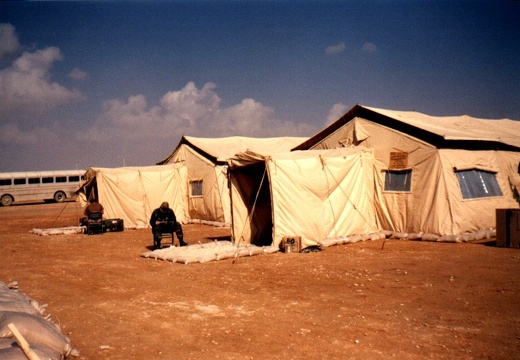
Tent City KKMC
Forward Operating Location (FOL) 1, King Khalid Military City (KKMC), Saudi Arabia
One ABDR team was up here.
